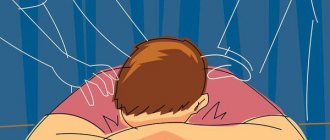If we talk about personality typology, according to “Psychoanalytic Diagnostics” by Nancy McWilliams, she identifies several leading types. In this article we will look at the paranoid personality type. The article is structured on the principle of gradually illuminating the main features of the type, its characteristics, signs, and peculiarities of how a psychologist works with it. The reader who is interested in issues of self-development, self-knowledge, and the study of psychology will find in this note information about one of the personality types.
Psychological characteristics of the paranoid personality type
The leading characteristics of the paranoid personality type are suspicion, wariness, absence or a dull sense of humor.
A paranoid person treats his qualities as negative, projecting them externally. And then they are perceived as an external threat. We can say that everything that this person worries and worries about is within herself. For example, such a person may not realize that in some of his manifestations he is quite aggressive and, projecting this quality onto other people, notes these traits in them.
Also often in paranoids one can observe a consciousness of their own greatness.
A paranoid person must suffer greatly in order to seek psychological help; they are not inclined to trust strangers. And in this regard, they tend to avoid consultations with psychologists and trust few people.
Paranoid individuals often play political roles where their projective traits may be opposed to existing views. They can “climb onto an armored car” to prove something to someone. True, it is important to note that such people do not always exaggerate the real danger. However, they can also be ironic and suspicious.
Description
Paranoid personality disorder is a pathological exacerbation of characterological traits such as suspicion, wariness, distrust, and readiness to display defensive aggression.
The synonymous name is paranoid psychopathy. The code in ICD-10 is F60.0. People with paranoid personality disorder are characterized by inflated self-esteem, excessive sensitivity to other people's opinions, to negative evaluation from others, a tendency to oppose themselves to the world, and a heightened sense of self-esteem. They are constantly looking for a threat from the outside, do not trust others, and fear attacks on their health, property and rights. The prevalence of paranoid psychopathy ranges from 2-3 to 14% depending on age, most often it is diagnosed in adolescents. Also, increased epidemiological indicators are observed among residents of large cities, among groups with low socio-economic status. Men are two times more susceptible to this disorder than women.
The pathogenesis of paranoid psychopathy is complex and multifactorial. The influence of biological and environmental factors is undeniable. Biological reasons include genetic predisposition and organic lesions of the brain, and environmental reasons include characteristics of upbringing, material and living conditions. The risk of developing paranoid personality disorder increases if the following factors are present:
- Psychological trauma in childhood. In the course of longitudinal studies, it was found that paranoid psychopathy is more often formed in adolescents and adults who experienced violence (physical, sexual, psychological) in childhood.
- Organic brain damage. The cause of psychopathy can be traumatic brain injury, stroke, drug and alcohol intoxication, or the onset of Alzheimer's disease.
- Hereditary predisposition. Sometimes paranoid psychopathy is the initial stage of schizophrenia spectrum disorders, so people with this type of personality disorder often have relatives with schizophrenia and schizoaffective disorders.
- Features of education. Paranoidity as a character trait is more often formed in people who were brought up in an atmosphere of competition with brothers and sisters, as well as those who lived with a stepfather or another person who “came” from the outside.
Drives, affects and temperament of paranoid personalities
It can be said about paranoid individuals that they are less suicidal than depressed ones. They are often unfriendly. They have a high degree of internal aggression and irritability.
It is difficult for a child to control their reactions; they may have an internal feeling that they are being persecuted.
In social interactions, paranoids may not be adaptive. Hyperexcitability is also noted. They struggle with hostile feelings and have many different fears.
Most often, paranoids experience a combination of fear and shame. This can lead to resourcefulness. Such people vigilantly monitor all interactions of other people among themselves and with them.
Narcissistic individuals may be subject to feelings of shame if the mask is somehow removed from them. Attempts are made to make such an impression on others that the devalued self will not be noticed by them. Paranoid individuals, on the contrary, use denial and projection. Shame remains completely unattainable within one's own self. Therefore, a paranoid person rushes headlong at those who are trying to shame and humiliate them. At the same time, narcissistic individuals are afraid of discovering their own inconsistency with some standards, and paranoid individuals are afraid of being judged by other people.
Paranoids can be noted to focus on the motives of other people, instead of focusing on their own “I”. They love to discuss possible motivations and consequences of other people's actions.
Paronoid individuals are vulnerable to envy. They cope with it through projection, believing that they envy them. In essence, we can say that they can project and deny those qualities of other people that they have in themselves. For example, the fact that they were betrayed.
Paranoid individuals project qualities that they may not notice or deny in themselves. For example, an office employee who is constantly late may make comments about this to other employees.
Paranoid individuals are not always aware of the guilt that is projected in the same way as shame. They believe that the psychologist, having learned about their sins, will reject them. They transform any feeling of guilt into a threat coming from outside. The fear of being exposed pushes them to recognize them earlier than others, thereby preventing evil intentions towards them.
Defense and adaptation processes in paranoia
The degree of projection in paranoids can be borderline or neurotic.
In a disturbed personality, the Ego is completely projected and external, no matter how much these projections may appear to other people.
Individuals with a preserved “I” still have the opportunity to test reality.
Borderlines act in ways that make their projections suitable for the target of the projection. For example, a woman who does not admit her hatred and envy may tell her psychologist that he is jealous of her. And she interprets the psychologist’s empathic manifestations as a desire to control.
In neurotic paranoids, their feelings are projected in a way potentially alien to the ego. Such a person projects, but at the same time a part of his own “I” remains, which, when forming a trusting working alliance between the client and the psychologist, can reach the level of awareness.
Paranoid individuals project their feelings externally, including in order not to recognize unbalancing relationships.
Psychologist Karen, exploring paranoid dynamics, summarized the basic psychological defense mechanisms of the individual. For example, how can a person with delusions cope with the desire for intimacy with a person of the same sex. At the same time, the person seeks to refute “I love him!” through a number of ways:
- Megalomania: “I don’t love him, I love myself!”
- Erotomania: “I don’t love him, I love her!”
- Delusional jealousy: “I don’t love him, she loves him!”
- Projection of homosexuality: “I don’t love him, he loves me!”
- Reactive formation: “I don’t like him, I hate him!”
- What allows me to hate him: “He hates me! If I hate him, I don’t love him!”
Paranoia: what to do, principles of treatment
Hospitalization is indicated in the acute period, when the patient is completely inadequate and can attack both relatives or acquaintances and completely strangers. In some cases, at the peak of delusional thoughts, the patient may try to commit suicide.
Treatment of paranoia in a hospital provides not only constant monitoring of the patient’s condition and intentions. When the syndrome worsens, it is very important to establish contact with a doctor, and often in such a situation the patient quite logically “integrates” taking medications into the structure and content of the delusional disorder.
For treatment, drugs from the group of antipsychotics are usually prescribed, and after remission is achieved, maintenance therapy with antidepressants, lithium-based drugs, and sedatives is possible.
Paranoia: how to get rid of the disease using non-drug methods
In addition to mandatory medication, psychotherapy is indicated. Group classes are ineffective and can lead to the opposite result - refusal of treatment. Therefore, at the Cordia Clinic we offer individual consultations. In a personal conversation, the doctor can determine how to treat paranoia and how appropriate it is to use potent drugs.
Physiotherapy is useful in helping to normalize sleep, reduce psychomotor agitation, and eliminate hyperreactivity of the nervous system. Sports activities have an excellent effect.
But doctors categorically warn against treating paranoia at home. Complications and worsening of the disorder can only be avoided with inpatient or outpatient therapy under the supervision of an experienced specialist. And the appearance of the first symptoms of the disease requires mandatory consultation with a doctor.
We do not give a 100% guarantee that we will be able to completely cure paranoia: some forms of the disease simply cannot be treated. But our doctors will select the appropriate medications and the right tactics of psychotherapy, which will allow you to achieve stable remission in the shortest possible time, when only maintenance treatment is required. Call us at +7 (495) 367-23-13 and sign up for a consultation!
Interpersonal relationships with paranoia
A child who grows up paranoid suffers from feelings of his own reality. He was subjected to periodic suppression and humiliation. The family can convey to the child that they are the only ones who can be trusted. This creates suspicion in the child towards other people.
Borderline or neurotic paranoid individuals come from a family system where criticism and ridicule predominate. The child may be a scapegoat.
Uncontrollable anxiety can trigger the development of paranoia in children. When a child came to such a parent with a problem, he either presented this situation as catastrophic, since he could not bear the child’s anxiety, or devalued it, since he could not condense it. Such an adult conveyed to the child that thoughts are equivalent to actions. And the child perceived that his personal feelings had dangerous power.
As children, paranoid individuals did not have the opportunity to express their feelings naturally and safely. In a psychologist’s office with such clients, a specialist teaches paranoid individuals to do this.
We can also say that paranoid individuals are capable of deep attachment and relationships.
Treatment in Re-Alt
Treatment of paranoid personality disorder is carried out comprehensively - psychotherapeutic methods are combined with drug therapy. The main condition for achieving successful results is establishing a trusting relationship with the patient, which is the main difficulty when working with such people. Due to their position in life, with elements of negativism, patients are reluctant to interact with a psychotherapist. The psychoanalytic approach is the most effective in correcting paranoid disorders. Therapy is long-term, much depends on the person's participation in the treatment process and the severity of the disorder.
Treatment of paranoid personality disorder in psychiatry is often carried out using psychoanalytic and cognitive behavioral therapy. A psychotherapist helps a person accept his feelings and develop more effective behavior patterns. For the specialist, the main task is to help the patient understand how to cope with the conflict caused by it, through reassessment and awareness.
Patients' reliance on denial directly affects the speed of treatment. This defense mechanism works by categorically refusing to acknowledge something specific. Direct interpretations of transference face even more denial. It takes a long time and support for a person to begin to accept the possibility that the shortcomings of others that he sees are in himself. A sign of successful treatment will be the person’s awareness that his negative thoughts and suspicions have no objective justification. With long-term therapy, it is possible to compensate for the severity of paranoid thinking, which increases with old age.
Drug treatment is prescribed, most often, during periods of deterioration of the condition and in short courses, due to the fact that a person may not take medications or consider them to be ineffective.
Paranoid Self
The paranoid client despises his own humiliated personality. He has a high degree of fear, which leads to the fact that he constantly “monitors those around him,” observes their reactions, “keeps his finger on the pulse.” Paranoids believe that they are the target of everyone around them, that people think and talk only about them.
It is also important to note that paranoids have a high sense of guilt.
Statistically, a connection has been found between thoughts about homosexuality and paranoid personalities, this has been confirmed by some studies.
Paranoids can fight against existing authorities. Revenge and triumph provide a temporary and shallow sense of security and moral clarity.
Transference and countertransference with paranoid individuals
Transference in paranoid clients is rapid and intense. The psychologist is the recipient of the projection of the image of the rescuer. But more often the psychologist is seen as an unsupportive, humiliating type. Such clients believe that the psychologist is trying to save them or, conversely, is focused on causing suffering. They evaluate a psychological assessment, believing that the psychologist wants to feel his own superiority.
Paranoid individuals may look closely at a psychologist. This can create a feeling of vulnerability and total protection. Transference here can be hostile and less often benevolent.
Countertransference may look like an opportunity to directly point out to the client that what the person perceives as a danger is unrealistic.
Therapeutic recommendations when diagnosing paranoia
The first requirement is the establishment of a stable working alliance with the psychologist. This is necessary to build trust, which will make it possible to build effective interaction.
If the paranoid client trusts the psychologist, then the work can be considered completed.
The main task for the specialist will be to increase the paranoid person’s access to the client’s inner world.
Jokes within reason can safely defuse aggression. They may relate to those topics within which the work is being carried out at a given time. For example, to a client who is overly worried about how he will look on a date, you can say something like this: “If you think that you will be examined under a microscope, take blood and urine tests, then rest assured that your your partner is also worried.” This, of course, is only possible after basic trust has been built in a psychological session.
If paranoids feel that their opinions are valued, they will become more open. You can find a way to demonstrate this to them. In addition, it is important to give the opportunity to talk.
Together with a psychologist, explore what led to such reactions. This stimulates separation, which will eliminate carryover.
It is important to teach paranoid clients to identify what triggers their paranoia. Starting from observing your own body and reactions to external factors that can trigger alarming symptoms.
It is also very important with paranoids to consider other reasons besides those used by paranoid individuals. Give me the opportunity to think about it for myself. There are clients who want ready-made, and even better, quick solutions to their problems. But at the same time, they do not always understand that instead of getting a fishing rod and then independently solving pressing problems that will arise in their lives, they want to immediately get a fish.
Emphasize the differences between thoughts and actions. “Just enjoy your fantasies!” Thinking about something does not mean doing it.
A psychologist should be very careful about boundaries. This may affect the paranoid's feelings of security. May cause anxiety. Something can be done with psychological boundaries if it is possible to identify them. And their identification is realistic only after identifying oneself.
Causes of paranoia
The etiology of the disease has not yet been fully elucidated. Unlike schizophrenia and some other mental illnesses, the connection between paranoia and genetic characteristics has not been confirmed. Experts suggest that the development of pathology may be due to:
- injuries, tumors, brain surgeries affecting the limbic system and basal ganglia;
- the influence of stressful life situations and circumstances;
- specific, hostile relationships in the family;
- social isolation, lack of communication, etc.
It is believed that the development of paranoia is predisposed by severe stress, accompanied by cruel (both morally and physically) attitude of others, strong envy, anger, which is why a person is left alone. He withdraws into himself, trying to find the reasons for what happened. Gradually, anxiety and restlessness develop, and a feeling of complete hopelessness appears. In such a situation, the formation of delusional, paranoid ideas is one of the mechanisms of subconscious psychological defense.
Differential diagnosis
Paranoid versus psychopathic client: If a paranoid person notes that you share their values with them, then they are capable of loyalty and generosity. Projection is a psychological defense mechanism in psychopathic and paranoid individuals. However, the former are not empathic, and paranoid individuals are deeply connected to the object (for example, another person). The experience of betrayal can be a threat. They perceive any violations of morality in their partner as a vice in themselves that should be eradicated.
Paranoid personalities in comparison with absessive ones: the latter are sensitive to little things, they are afraid of control, but do not experience the fear of physical harm, moral humiliation, which is typical of paranoid personalities. Absessive clients try to cooperate with the psychologist, although they may have alternative positions. A violent reaction to clarification at work may indicate that the client has dominant paranoid qualities.
Paranoid versus dissociative personality: Paranoid traits may be present in dissocial personalities.
Next, let's look at the depressive personality type.
Sources
- A. B. Smulevich. Borderline mental disorders // Guide to psychiatry / ed. Tiganova A.S. - M.: Medicine. 1999.
- Katernaya Yulia Evgenievna Paranoid, schizoid and hysterical personality disorders among adolescents who have not previously sought psychiatric help // Medical almanac. 2015. No. 4 (39).
- Gorinov Viktor Vasilievich Personality disorders in adulthood and old age: on the issue of the outcome of personality pathology (analytical review) // Russian Psychiatric Journal. 2009. No. 5.
- Volodin B.Yu., Sochivko D.V., Yakovlev V.V., Frolov A.I. Current state of the problem of personality disorders // Personality in a changing world: health, adaptation, development. 2021. No. 2.
- A. Skodol. Paranoid personality disorder. 2021.









